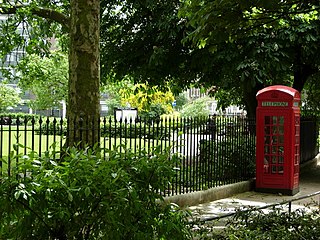University College London, which operates as UCL, is a public research university in London, England. It is a member institution of the federal University of London, and is the second-largest university in the United Kingdom by total enrolment and the largest by postgraduate enrolment.

Bloomsbury is a district in the West End of London, England. It is considered a fashionable residential area, and is the location of numerous cultural, intellectual, and educational institutions.
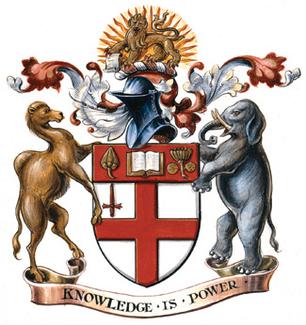
SOAS University of London is a public research university in London, England, and a member institution of the federal University of London. Founded in 1916, SOAS is located in the Bloomsbury area of central London.
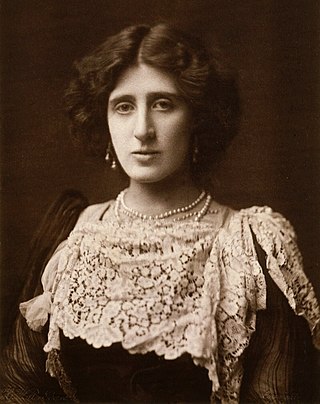
Lady Ottoline Violet Anne Morrell was an English aristocrat and society hostess. Her patronage was influential in artistic and intellectual circles, where she befriended writers including Aldous Huxley, Siegfried Sassoon, T. S. Eliot and D. H. Lawrence, and artists including Mark Gertler, Dora Carrington and Gilbert Spencer.

Fitzrovia is a district of central London, England, near the West End. The eastern part of area is in the London Borough of Camden, and the western in the City of Westminster. It has its roots in the Manor of Tottenham Court, and was urbanised in the 18th century. Its name was coined in the late 1930s by Tom Driberg.

Russell Square is a large garden square in Bloomsbury, in the London Borough of Camden, built predominantly by the firm of James Burton. It is near the University of London's main buildings and the British Museum. Almost exactly square, to the north is Woburn Place and to the south-east is Southampton Row. Russell Square tube station sits to the north-east.

Bloomsbury Square is a garden square in Bloomsbury, in the London Borough of Camden, London. Developed in the late 17th century, it was initially known as Southampton Square and was one of the earliest London squares. By the early 19th century, Bedford House along the north of the square had been demolished and replaced with terraced housing designed by James Burton.
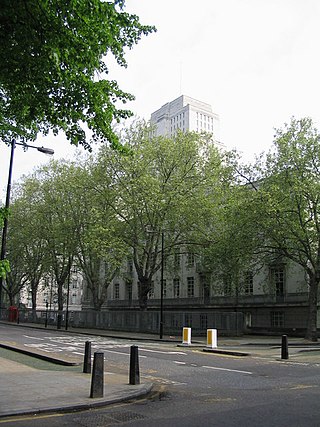
Malet Street is a street in Bloomsbury, in the London Borough of Camden, Central London, England. It runs between Torrington Place and the British Museum, parallel to Gower Street and Tottenham Court Road.

Universities and Colleges Christian Fellowship is a UK-based charity that was founded in 1928 as the Inter-Varsity Fellowship of Evangelical Unions. UCCF's dual aims are:
- To advance the evangelical Christian faith amongst students, graduates and former members of universities; and
- To promote biblical scholarship and research.
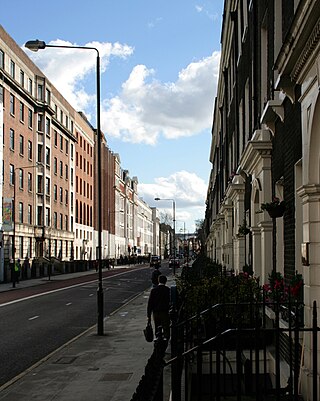
Gower Street is a two-way street in Bloomsbury, central London, running from Euston Road at the north to Montague Place in the south. The street is continued from North Gower Street north of Euston Road. To the south, it becomes Bloomsbury Street.

Blind Veterans UK, formerly St Dunstan's, is a large British charity, providing free support and services to vision-impaired ex-servicemen and women and National Service personnel. Blind Veterans UK is a registered charity in England and Scotland and operates throughout the United Kingdom. It has its head office in London and centres in Brighton and Llandudno.
Filming periodically takes place at University College London. The university tends to be chosen as a location for film and television recording because of its convenient position within London and the historical character of the UCL Main Building and Front Quad. Film and TV appearances include:

The Bedford Estate is an estate in central London owned by the Russell family, which holds the peerage title of Duke of Bedford. The estate was originally based in Covent Garden, then stretched to include Bloomsbury in 1669. The Covent Garden property was sold for £2 million in 1913 by Herbrand Russell, 11th Duke of Bedford, to the MP and land speculator Harry Mallaby-Deeley, who sold his option to the Beecham family for £250,000; the sale was finalised in 1918.

The UCL Queen Square Institute of Neurology is an institute within the Faculty of Brain Sciences of University College London (UCL) and is located in London, United Kingdom. Together with the National Hospital for Neurology and Neurosurgery, an adjacent facility with which it cooperates closely, the institute forms a major centre for teaching, training and research in neurology and allied clinical and basic neurosciences.

The House of St Barnabas, at 1 Greek Street, Soho, is a Grade I Listed Georgian building in London notable for its rococo plasterwork interiors and for other architectural features.
This is a list of the halls of residence at University College London in London, England.
Mary Trevelyan was warden of the Student Movement House then founder and governor of International Students House, London, and founder of the Goats Club for foreign students. Through most of her working life, Mary Trevelyan worked to solve the problems of overseas students in London, to help them establish the best possible memory of Britain and the British people, and to promote international friendship amongst these students which could be continued even after they left Britain. Trevelyan was appointed as both an OBE and later promoted to CBE. She died in Newbury, on 10 January 1983 after a long illness.
This is a list of the etymology of street names in the London district of Bloomsbury. The following utilises the generally accepted boundaries of Bloomsbury viz. Euston Road to the north, Gray's Inn Road to the east, New Oxford Street, High Holborn, Southampton Row and Theobald's Road to the south and Tottenham Court Road to the west.
Margaret Sewell (1852–1937) was an English educator who was Warden of the Women's University Settlement. She was a pioneer advocate of social work.






